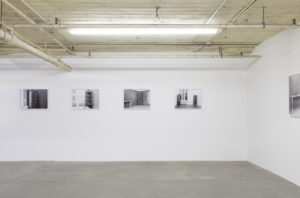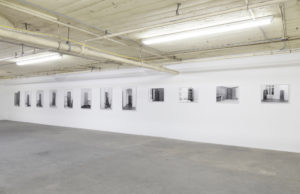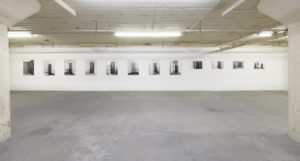Jay Chung & Q Takeki Maeda: SOLUTIONS TO COMPOUND PROBLEMS
- Jay Chung & Q Takeki Maeda interviewed by Alexandra Noel
Alexandra Noel: SOLUTIONS TO COMPOUND PROBLEMS rapidly progresses forward and backward in the narrative construct of your artistic career and art history, creating a subtle dizzying effect through a variety of concisely intertwined bits of information and documentation. These details and records are comprised of your past site-specific work as well as historical textual references to the gallery you have shown them in. And with the past covered, the present lies in the context. The work becomes “new” based on its new context at 356 Mission and its new form as photographs, with one piece remaining in its original form as text from its previous show. And even so, this text has been transcribed from correspondence letters, applying another layer of historical context and narrative.
Can you describe how your two site-specific pieces When Buffeted (Toter Winkel), 2009 and Untitled, 2014, both shown at Galerie Isabella Bortolozzi in Berlin evolved into the works shown at House of Gaga in Mexico and 356 Mission in Los Angeles this year? Would you say this is an act of recycling or reimagining an old work? Do you think the artist’s narrative (factual or fictional) is crucial to understanding the work?
Jay Chung & Q Takeki Maeda: That’s a good question. I think one way to describe what you are speaking of is the term survol. In our grad classes, we tried to describe how Flaubert wanted to see his drama from high above so the characters would be seen from a distance, their motivations completely insignificant, like the way we look down on ants. He would then be coldly disengaged from their desires, totally disinterested. It’s a criticism of Flaubert, but it’s also critical to his project.
In the show at Mission 356 you’re actually looking at one installation that photographically depicts two previous works. That alone is a kind of distancing device. It’s not recycling, but using presentation to look at the works in a different way. The images describe a way of working in a specific context and location, but they don’t reproduce the conditions under which the work was made. For example, at the time we were installing Toter Winkel, we were only begrudgingly allowed to put the cabinets in every room of the gallery. This was a tense situation, a real problem. In American art-school-speak we say problem when we are talking about an artistic issue, but this was more like a disagreement. You had an artistic motivation colliding with the interests of the gallery. In the photographs you don’t see this at all, and in fact it’s hard to believe because the views are so serene.
I’m not sure what you mean by artist’s narrative. If anything I think that idea should be undermined. If you look at the pieces we’ve made that allude to our own biography, they are always farcical. We produced this elaborate event for our 10th anniversary, but you could argue that 10 years of Jay & Q is a totally empty statement. That emptiness is a kind of selflessness. Not an ecstatic selflessness, but a refusal. So is our treating a working context as a given field of desires and motivations that have nothing to do with our own tastes or biography. For example, Toter Winkel was based our gallerist’s desire to project an aesthetic identity––to put in the most crass, oversimplified way. Untitled was based on a literal, person-to-person confrontation between two people, our gallerist and her upstairs neighbor. These kinds of things are way more interesting than some kind of coherent, self-mythologizing narrative.
AN:Can you describe the two pieces previously installed at Isabella Bortolozzi Galerie? Did Untitled in 2014 address the Bortolozzi gallery space like When Buffeted (Toter Winkel) did in 2009?
JCQTM: The Toter Winkel installation involved the placement of one corner cabinet in every corner of the gallery. The cheap veneer finish of the cabinets both complement and deface the wood paneling of the interior architecture. Also, the cabinets’ shape dictates their placement. You can’t put them in the middle of the room, because two of the cabinets’ three faces are just raw, unfinished blank sheets. Their form prevented us from making a decision about where they go. As far as the second work, the original installation of Untitled is composed of three elements, two sculptures and a woodblock print. The two sculptures represented Monika Schmela and Ulrike Schmela-Brüning, and the print represented Lena Brüning. We call these elements portraits, but we’ve never actually met Brüning, her mother, or her grandmother, and outside of reading about them at the Getty Research Institute, we know nothing about them. So the elements are solipsistic. Instead of directly portraying anyone, their material and formal properties are derived from the characteristics of the décor of Galerie Bortolozzi, where the show took place. They mimic their environment, and in that way Untitled is similar to Toter Winkel.
AN:Could you describe your interest in the history of Galerie Lena Brüning that briefly operated above Bortolozzi and why you chose to transcribe the correspondence letters? Was the apparent theme of disappointment and frustration between gallery directors and artists of interest to you? The gallerists often mention, out of politeness or sincerity, that they are “waiting for a trend to end” so they can show an artists’ work.
JCQTM: Galerie Lena Brüning is a young gallery that was established by the granddaughter of Alfred and Monika Schmela, who together founded the Galerie Schmela in Düsseldorf in the 1950s. The Schmelas opened with Yves Klein and are credited with discovering Beuys, so they are considered to be very important in the history of postwar German art. Ulrike Schmela-Brüning, Lena Brüning’s mother, also played a major role in the gallery. Galerie Schmela closed in the 1990s, but Brüning later opened her own space in Berlin, I think sometime in the 2000s. After initially running the space somewhere else, Brüning recently decided to relocate her gallery upstairs from our gallery in Berlin, and this move resulted in the kind of conflict or rivalry that might occur when two galleries become neighbors. In this case the rivalry was spatially manifest, with the two spaces having an almost identical floor plan. It was through this conflict that Brüning’s family heritage became interesting to us.
After the Galerie Schmela closed in the 90s, they arranged to have their archive of correspondence and paperwork preserved at the Getty Research Institute. The correspondence starts in the 1950s, so you could say we had access to the gallery’s entire history. The booklet in the show at 356 Mission is a translation and index or digest of selected letters—kind of like cliff’s notes. It also works as a kind of epistolary novel. The text focuses on the period after 1980, when Lena Brüning was born. At this point in time the correspondence refers to all three women, Monika, Ulrike and Lena, who is just a baby. The 1980s was also the time when the contemporary relevance of the gallery was in question. As it turns out, I could identify totally with Monika and Ulrike, and I think the sadness of the letters is not at all something fabricated. In that sense, it’s not just a theme or structural principle. Although it was hard to reduce an entire archive of correspondence to something readable, I think the result is satisfying because one reads between the lines according to ones own experiences. For example, you read that the gallery told Kenneth Capps they would have to postpone his show until the neo-expressionist trend was over, but then in the very next letter––this is not set up, the letters are in alphabetical order—they are begging Sandro Chia and Enzo Cucci for work.
AN:How would you say sadness or points of contention in the art world relates to your work? Could you compare your identification with the sadness of the Schmela letters to your piece Modus Tollens made in 2003, in which you pretended Q would be returning to Japan and you would no longer see each other or be making work together?
JCQTM: I’ve never really compared the two! I guess the reason why these points of contention are interesting to me is because I believe that the milieu of contemporary art could be made to be meaningful beyond it being shorthand for the world of luxury and leisure, or the misguided idea of creative freedom people always seem to be promoting, if only one could capture all the nuances.
AN:Do you think these two projects (Toter Winkel and Untitled) will continue to manifest throughout the future of your art career? If so, will it be that case that until you’re “done”, the piece or body of work will not be fully realized? This idea could be applicable to the career of any artist.
JCQTM: Coming back to grad seminar at Art Center College of Design, another text we assigned was Foucault’s The Lives of Infamous Men. You have to understand Foucault’s texts on authorship together with that text, or other ones, like About the Concept of the Dangerous Individual. They are all about the same thing. The coherence of the author only appears as an effect, and this is totally divorced from the real fact of the person’s actual existence. The author is just like someone who is accused of a heinous crime. They are the passive party, not the active one. For example, in Lives… Foucault describes how before the French Revolution, if a common person was annoyed with someone, they would write these elaborate letters to the king’s administration describing the guy’s misdeeds. In their best, most florid language, the accuser would try to make the accused out to be as monstrous as possible in the hopes that the king would respond by imprisoning the guy. Foucault says that these letters were an attempt to appropriate the king’s power through language. I think that when you look at any instrumental writing from the art context, like a press text or catalogue essay, you basically see the same impulse. Out of this impulse comes the notion of an artist’s career or body of work. OK, enough with the Foucault.
AN:What was your interest in showing Lev Kalman and Whitney Horn’s film, Blondes in the Jungle in conjunction with your show at 356? There was a disclaimer at the beginning, which read “everything in this film, even that which is presented as fact-is fiction”. How does this film relate to the video Untitled shown at REDCAT in 2012, in which the dialogue of older artists sharing their antipathy for younger artists was portrayed?
One idea that comes to mind when making this comparison is the fact that the teenagers in Blondes in the Jungle are in an extremely dangerous environment and yet nothing happens to them. They spend most of their time telling stories and taking drugs while seeking out the fountain of youth. The only point of ideological disruption seems to be most likely induced by their excessive highs. One of the male teenagers violently kills two small monkeys with a machete, an animal that has no real threat and one that the female teenager finds endearing.
JCQTM: Kalman and Horn’s films blew us away because they successfully do something we are trying to do, and all the while using an idiom that is so close to the one I grew up in. Straub Huillet is great and all, but this is like if they were my best friends growing up. By the way, if I’m not mistaken, the live monkey shots were filmed at the Bronx Zoo and later intercut with the shots of Amber’s face in Honduras. When you see the film again, that will strike you as exceedingly poetic. A friend of mine was positioning Kalman and Horn’s films in contrast to Renzo Martens’. He was saying Martens’ relies on making the poverty of his subjects a spectacle to satirize the ignorance and apathy of the viewer. On the other hand, in Blondes in the Jungle, which takes place in Honduras, you only ever see these privileged, beautiful teenagers. It is definitely, without question, related to the video you mention, and I’m so happy you see the connection.
Blondes in the Jungle screening and discussion with Jay Chung and filmmaker Lev Kalman
December 7, 2014Reading with Jay Chung
December 6, 2014



